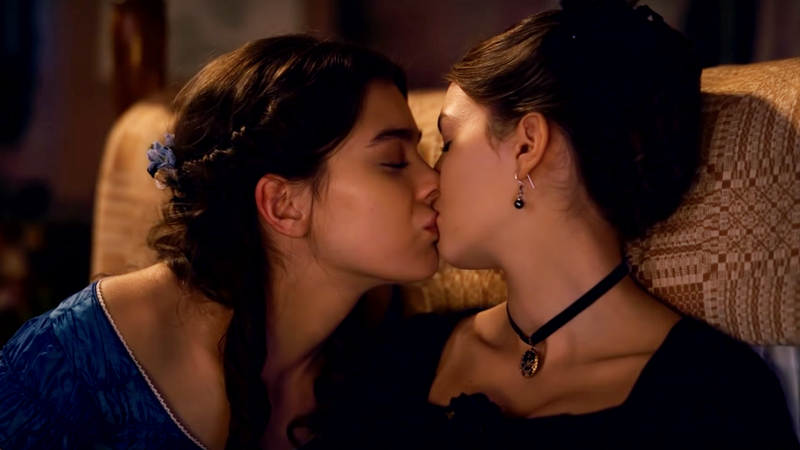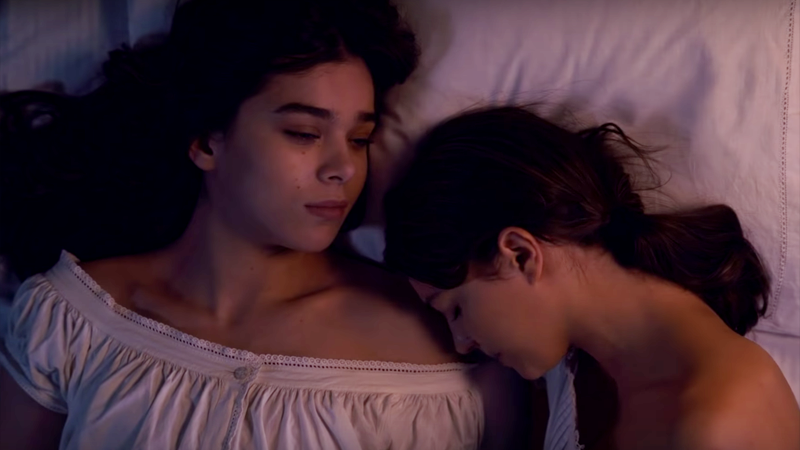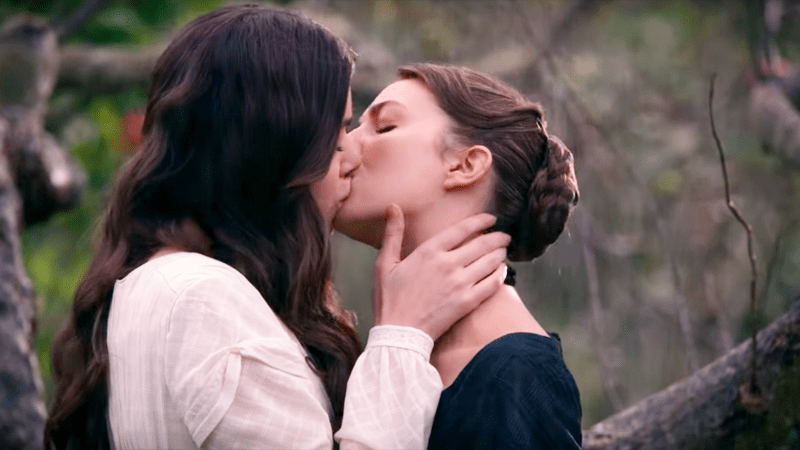It doesn’t take long to establish the concept for Dickinson: a voiceover summary of America’s best-known female poet, a vision of how she, as a young woman in the late 19th century, might have gone about her mystical art of conjuring words, until she’s interrupted at 4am with the reality of her domestic chores; her frustrated reaction punctuated with a petulant “bullshit” then bass drop into the credits. Let’s take everything we thought we knew about Emily Dickinson, tear it up, wave the lens of a teen comedy over it and see what crazy hijinks we get up to.
Through ten half-hour episodes, we follow Emily through the ups and downs of her early adulthood, from Skins-style parties to carriage rides with death, while on the cusp of entering her most prolific creative period. Throughout these antics are woven various threads that form an overall sort of a storyline, largely involving her equally eccentric family members. Emily fights for the freedom to write her poetry and be recognised for it and grapples with the expectations heaped upon a wealthy daughter of marriageable age, all with a very modern kind of sneering exasperation.

Probably the most engaging storyline, and let’s face it, the main reason a whole lot of people will take an interest in the show, follows Emily’s relationship with childhood friend Sue Gilbert. There’s angst but no slow-burn here, as we quickly acknowledge that the two share the kind of love surpassing anything possible with the various suitors being foisted upon them. Needs must though, and Sue’s acquiescence to marry Emily’s boorish brother Austin for financial stability creates a love-triangle that bookends the season and provides the emotional beats that really underpin the whole story. While the assertion that Sue understands Emily better than anyone tends to only be enforced by Emily saying it a lot, there’s an undeniable chemistry and a whole lot of fun as we follow them through magical orchard kisses, dressing up as boys to infiltrate the local college and a volcanic bedroom scene. For sure, if you are the kind of person that reimagines every historical novel or period drama with the plucky heroines kissing each other, you will find great joy here.
Looking beyond the gay, things get a little shakier. While “Emily Dickinson, but as a millennial comedy” makes a great elevator pitch, making it work over ten episodes is a challenge. Yes, we have dance montages, drama clubs and awkward family dinners where you really wouldn’t be surprised if Emily blurted out “So, I was nailing her.” But once the bombastic anachronisms that litter the first three episodes peter out, the season sags a bit, charting a perfunctory romance with her dad’s (male) legal clerk Ben, chock full of lines ripped straight out of Four Weddings and a Funeral, and an outright face-palming episode on race. Some side-plots don’t quite pay off, like Lavinia dealing with the fallout from a nude self-portrait, and feel a bit like the writers were congratulating themselves for contriving a way to shoehorn modern slut-shaming into the 19th century, perhaps undermining the impact of the storyline and certainly unnecessary considering the many other examples we have from millennia of misogyny.

The parts that tended to work for me were the flippant asides that weren’t too overplayed — like Emily trekking to visit Thoreau and finding him living in a tourist hotspot with his mum and sister round the corner, or Louisa May Alcott as a money-obsessed hustler who’ll write anything for a few dollars. I think more rapid-fire absurdity (like the shot of Emily’s bizarre bird nest collection) would help offset the clunkier parts of the show. As it was, sometimes it was hard to tell what was intentionally over the top. To this day I am flummoxed as to whether Maggie the maid’s Irish accent was meant to be a joke, or she just learnt it from watching KStew in Lizzie. Nor was I fully sold on the scenes with Wiz Khalifa’s death, where I wanted to see the surrealism pushed even further.
At the heart of the show, this version of Emily is definitely engaging. Yes, she’s a little bratty (even her mum calls her out as spoilt when she cringingly compares herself to a slave in the first episode) and even domineering, but it makes sense to push her character to the max if you’re trying to flip conventional portrayals on their head. Importantly, she is not at all troubled by her own queerness and proudly sits like a bisexual.
I am here for as many revisionist takes on history as you want to throw at me if it’s correcting centuries of queer omission. Despite the 1000+ poems, all the correspondence and contemporaneous accounts that drive the Emily Dickinson scholarly machine, the cracks between the words have always incubated speculation about certain aspects of her personality, seeding legends easily manipulated by posthumous editors with their own agenda. Certainly, I don’t view takes like this as any less valid than the image of her peddled by Mabel Loomis Todd, the first to edit and publish Emily’s collected work, who purposefully erased and replaced the frequent mentions of Sue’s name to make the work more acceptable to conservative audiences. Arguably, all takes on Emily Dickinson have been revisionist from the get-go, and the series takes delight in lampooning them to riff on its own hypotheses. What if Emily wasn’t really ill all the time, she just faked it to get some peace and quiet to write? What if Emily wasn’t a recluse at all, and not only threw wild parties, but was the one dripping opium on everyone’s tongues?
The irreverence of these scenes really pop thanks to the immaculate production that nails the period detail. If there’s one thing the show does not play fast and loose with, it’s the incredible amount of research that’s obviously gone into it, which you can see in the little things like the family portraits on the wall and apparently the wallpaper itself. So many seemingly inconsequential things, like Emily lowering her basket out the window, or baking, or even the book Ben gives her are rooted in truth, which makes subverting it all the more fun.

Conversely, it feels like the character of Emily is a lot weaker when she’s being rammed into the template of an identikit modern heroine. Her boldly-stated desire to be the greatest poet in history and publish against her father’s will seems a bit forced, like it’s just because it would be weird for audiences today to have a heroine that didn’t want these things and wasn’t prepared to fight the patriarchy for it.
The same holds true for most of the characters, who are either flimsy stereotypes or struggling to break out of narrow parameters. Sue is mostly reduced to the romantic interest, whose only initial character trait seems to be that her family is all dead (only a minor exaggeration). It’s a nice touch when this gets played for more than laughs, and we see how it shapes her reaction to Emily’s feigned illness, or her fears for having a family of her own. It’s a real shame we don’t get to see that Sue was a prolific writer and intellectual in her own right. Sister Lavinia is stuck with the overshadowed younger sibling trope and we never get much further than her desperate attempts for attention, sexual or otherwise. Emily’s mum starts off a but stilted but gradually eases into the kind of Jane Krakawski role you know and love, getting full-on Jenna Maroney by the final episode, with cackhanded attempts to beautify herself with household poisons. There are also male characters in the show, that I seem to have forgotten all about.
I was left with the feeling that the series is trying to hit a lot of bases and sometimes missing, and would maybe be better off just sticking to one thing and knocking it out of the park. If you’re going to be a snarky teen soap, really get your characters nailed down. If you want to be an absurdist comedy, get really absurd! Show creator Alena Smith said that she deliberately avoided watching recent films about Emily Dickinson, including 2017’s po-faced A Quiet Passion, and last year’s incredible Wild Nights With Emily, for fear of warping the vision she’d been developing for years. While that’s totally understandable, it’s hard as a viewer not to make those comparisons. In Wild Nights, there’s a scene where Emily and Sue battle with the endless layers of petticoats in the way of their passion, which had me in stitches. Dickinson uses a similar idea, but she wants to get through all those skirts to see if she’s bled through from her period. I feel like too often the show is trying to be a bit too clever, and it’s at the expense of actual laughs.
I’m really glad this show exists, and that it’s been renewed for a second season. Not just because it proves there’s an appetite for female-centric (and female-made) comedy but because there’s genuinely a lot of fun and smart stuff in this first season. Here’s hoping the show doubles-down on the stuff that works, sidesteps some of the clunky errors, and continues to serve up lashings of the kooky queer heroine we all want to see.

“There are also male characters in the show, that I seem to have forgotten all about.”
I love this.
Came down here to quote the very same line 😂 Sally ilu
Well I didn’t want to give the inaccurate impression that the show is a female-only utopia but also I have attention deficit issues regarding men on tv
I’ve decided the whole point of Ben was to have someone in Emily’s life die who wasn’t Sue
Yes, I was totally on board with this subversion of dead lesbian tropes!
I just wish that Emily didn’t get so gross about wanting to cook him dinner and stuff, kind of plays into the “queer women are essentially straight if they’re with a guy” nonsense stereotype. I know she eventually resolved that, but still GROSS
Sally, you had me at “Louisa May Alcott as a money-obsessed hustler who’ll do anything for a few dollars”.
Humour that highlights (for instance financial) realities in absurdist ways does more for me than dull supposed accuracy that really is just as contrived.
Louisa May Alcott was my favorite character, I think, edging out even Emily herself. She was delightful. I mean: “That’s why Hawthorne called us ‘a damned mob of scribbling women’. But Hawthorne can eat a dick, am I right?”
That period scene is still one of the most real representations of periods I have ever seen, in any visual media ever. It’s worth watching for that alone
I’ve been so excited to read your take on the show after marathoning it in one evening! It’s a really ambitious show, which means as you said a lot of hits but also inevitably a lot of misses. also agree re: “the flippant asides that weren’t too overplayed” being a highlight, I loved the louisa may alcott and thoreau stuff especially since i lived in concord once. anyhow you really nailed it! just like emily nailed sue!
I visited Concord once and my overriding memory is of these really robotic girls doing the guided tour around Emerson’s house and reciting millions of Emerson facts so now I will imagine that you were one of those guides.
The show weirdly performs its own kind of gay erasure by shoehorning the hetero romance into the show despite ANY historical evidence for it and allows that relationship to dominate the latter half of the season. She considered that guy as a brother or teacher in real life. what a load of garbage.
It’s weird because on the one hand their relationship is overblown as you say, e.g. she never nursed him on his deathbed and only found out he died from the newspaper BUT it was effectively fridging the male love interest to further the female protagonist’s journey and re-center her love for another woman, which never happens !
I AM CONFLICTED
The thing that struck me most about the series was that Emily and Sue’s love for each other was pretty much an open secret amongst family and friends.
I may have demonstrated Louisa May Alcott running in petticoats for my runner daughter. She loved it.
I love this show and take it as it comes. The missteps if there are any add to this madcap crazy show. So entertaining